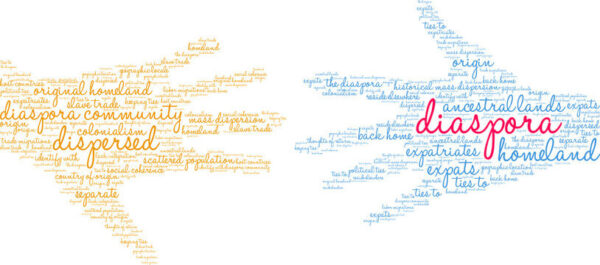Diaspora communities refer to individuals who have been uprooted from their ancestral homeland and relocated elsewhere in the world. That is diaspora communities meaning. These groups often face challenges maintaining their cultural identity while adapting to new environments and lifestyles.
This article will examine the experiences of diaspora communities definition in Europe and how they have strived to preserve their cultural heritage. It will look at various strategies and initiatives these groups have implemented, such as language schools, cultural festivals, and community centers. Furthermore, it will emphasize the significance of preserving cultural identity and its benefits for individuals and society at large.
Diaspora meaning refers to the dispersion of a particular group of people from their homeland to various parts of the world.
The Importance of Preserving Cultural Identity


For diaspora communities, preserving cultural identity is essential as it provides a sense of continuity and connection to their ancestral homeland. It helps to maintain a sense of belonging, especially for those who may feel isolated and disconnected in their new environment. Cultural identity also serves as a source of pride, allowing individuals to celebrate their heritage and share it with others.
However, preserving cultural identity in diaspora communities can be challenging. The pressures to assimilate and adapt to the dominant culture can make it difficult to maintain traditions and practices. Additionally, younger generations may not have the same level of attachment to their cultural heritage, leading to a loss of cultural knowledge and practices over time.
Despite the challenges, there are many benefits to preserving cultural identity for diaspora communities. It allows individuals to maintain a connection to their roots, which can provide a sense of comfort and stability in an ever-changing world. It also helps to promote cultural diversity and understanding, which can lead to greater social cohesion and harmony.
Economic Benefits
Preserving cultural identity can also have economic benefits. Cultural tourism, for example, can provide a significant source of income for communities that preserve their traditions and heritage. Additionally, cultural expressions such as art, music, and cuisine can be marketed and sold to a wider audience, creating new economic opportunities for individuals and communities.
In conclusion, preserving cultural identity is crucial for diaspora communities. It helps to maintain a sense of connection and belonging, promotes cultural diversity and understanding, and can have economic benefits. Despite the challenges, diaspora communities have implemented various strategies and initiatives to preserve their cultural heritage and ensure that it is passed down to future generations.
Examples of Diaspora Communities in Europe


A list of diasporas includes the Irish, Chinese, Armenian, and Greek diasporas, among others.
Europe is home to several diaspora communities from around the world, each with their own distinct history, culture and experiences. Here are some examples of top 10 largest diasporas in Europe (They are also the largest diaspora by percentage of population):
Turkish Diaspora
The Turkish Diaspora in Europe: The Turkish diaspora in Europe is one of the largest and most established diaspora communities in the region, consisting of five million people primarily living in Germany, France, the Netherlands, and Belgium. To preserve their heritage, they have established numerous cultural organizations, mosques, and community centers. Furthermore they organize cultural festivals and events like the annual Turkish Festival in Berlin to promote Turkish culture and traditions.
Indian Diaspora
The Indian Diaspora in Europe: The Indian diaspora in Europe consists of approximately two million individuals, mostly living in the United Kingdom, Germany, and France. They are renowned for their contributions to business, medicine and technology as well as setting up cultural organizations such as temples and community centers to preserve traditions and facilitate cultural exchange. Major festivals like Diwali and Holi are widely attended by people from all backgrounds.
Cultural diaspora examples include the spread of Italian cuisine around the world, the popularity of Korean pop music, and the adoption of yoga in Western cultures.
African Diaspora
The African Diaspora in Europe: The African diaspora in Europe consists of people from various African countries who have settled here for various reasons, such as education, employment or asylum. They have established numerous cultural organizations, community centers and Afrocentric festivals and events to celebrate African culture and traditions. Furthermore, members of this diaspora are actively involved in advocacy work around issues affecting Africa and its people.
Chinese Diaspora
The Chinese Diaspora in Europe: The Chinese diaspora in Europe is one of the oldest and most well-established diaspora communities in the region, consisting of around 1.7 million people primarily living in the United Kingdom, France, and Germany. To preserve their heritage and promote cultural exchange among members from various backgrounds, they have established numerous cultural organizations, community centers and schools for this purpose. Furthermore, they celebrate major Chinese festivals like Chinese New Year which attract people from all backgrounds.
Other


If you want to travel to Europe after 2025 you should take into consideration new travel regulations. From 2025, nationals of 58 countries worldwide enjoying visa-free access to the EU will be required to have valid ETIAS authorizations upon arrival at the border. This is going to change a lot of things for travelers around the world.
Finally, diaspora communities in Europe are diverse and each has its own history, culture and experiences. To preserve their heritage and promote cultural exchange among members, these groups have formed organizations, events, and initiatives. By maintaining their cultural identity, these diaspora communities enrich Europe’s cultural diversity while contributing to an inclusive and harmonious society. For the information, the largest diaspora per capita is the Lebanese diaspora, with an estimated 14 million Lebanese living outside of Lebanon, which is more than three times the population of Lebanon.
Strategies for Preserving Cultural Identity
Language is an integral component of cultural identity, serving as a vehicle for communication and transmitting cultural values, beliefs, and traditions across generations. Therefore, protecting language in diaspora communities is vital. Language preservation programs aim to teach, promote and safeguard languages that may otherwise become extinct – especially those not widely spoken or taught in mainstream education systems. These initiatives may take various forms such as language classes, immersion programs, camps for language exchange students or exchange programs between speakers.
Transnational communities meaning refers to communities that span across multiple countries, often involving members of diaspora communities.
For instance, the Irish government established the Gaeltacht program to safeguard and promote Irish language, which is at risk. It offers support to Irish-speaking communities while offering language immersion programs for young people to learn the language and experience Irish culture. Similarly, Wales established Welsh Language Initiative with a mission of maintaining Welsh as a living language.
Studies have demonstrated the power of language preservation programs to safeguard and promote endangered languages. A study by the University of Arizona discovered that Navajo immersion programs in the United States have been successful at revitalizing their language and culture among young people, while another study conducted at University of California-Los Angeles revealed an increase in fluent Cherokee speakers through a revitalization program run by Cherokee Nation officials.
Finally, language preservation programs are essential for maintaining cultural identity within diaspora communities. They play an integral role in safeguarding endangered languages and cultures, preserving them as vibrant pieces of the world’s cultural diversity. By investing in language preservation initiatives, diaspora communities can safeguard their identity, strengthen their communities, and contribute to a more diverse and inclusive society.
Community organizations and associations


Community organizations and associations have played a pivotal role in safeguarding cultural identity within diaspora communities. For instance, the Turkish Cultural Center in New York has implemented programs to promote Turkish language and culture through classes, events, and interfaith dialogue forums; similarly, Indian American Associations in California organize cultural celebrations such as Diwali and Holi to celebrate Indian customs and traditions.
Studies have demonstrated the power of community organizations and associations in diaspora communities to preserve cultural identity. A study by the University of California, Los Angeles revealed how Korean-American community organizations in Los Angeles had played a crucial role in upholding Korean culture and language, especially among younger generations. Meanwhile, another study from Oxford revealed how Somali diaspora organizations in the United Kingdom have played an essential role in fostering and protecting their cultural identity.
Finally, community organizations and associations are essential for maintaining cultural identity within diaspora communities. They offer a space for members to come together, exchange experiences, and uphold traditions and values. By investing in these organizations and associations, diaspora communities can preserve their culture identity while strengthening their communities while contributing towards creating a more diverse and inclusive society.
Cultural events and celebrations
Cultural events and celebrations are an essential strategy for maintaining cultural identity in diaspora communities. They give community members a chance to come together, honor their heritage, and share traditions and values with others. Furthermore, such gatherings help reinforce cultural identity and foster belonging within the group.
Cultural events and celebrations include traditional festivals, music and dance performances, cultural fairs and markets, as well as art exhibitions. Examples of diaspora communities around the world that take part in these festivities include Chinese New Year celebrations, Diwali festival, and St. Patrick’s Day parade.
Data regarding attendance and impact of cultural events and celebrations varies depending on location and size. However, studies have demonstrated that such occasions can have a significant effect on promoting cultural identity and creating a sense of community among diaspora members. For instance, researchers at the University of Bristol discovered that St. Pauls Carnival in the United Kingdom–which celebrates African and Caribbean culture–has had an encouraging effect on diaspora cohesion and identity building.
Cultural events and celebrations are an essential strategy for maintaining cultural identity in diaspora communities. They give members of these groups a chance to come together, honor their heritage, and share traditions and values with others. By investing in cultural activities and celebrations, diaspora communities can safeguard their identities while strengthening their communities and contributing to a more diverse and inclusive society.
Education and cultural transmission


Successful education and cultural transmission programs emphasize teaching cultural practices, customs, and history through formal and informal education. For instance, language classes, cultural workshops, and mentorship programs that impart traditional skills and practices are effective methods to preserve cultural identity.
Data regarding the effectiveness of education and cultural transmission programs varies depending on their location and scope. However, studies have demonstrated that these initiatives can have a significant effect on fostering cultural identity and upholding traditions among diaspora communities. For instance, researchers at the University of California Los Angeles found that Korean language schools in Los Angeles have been successful at maintaining Korean cultural identity among younger generations of Korean Americans.
In conclusion, education and cultural transmission are critical strategies for maintaining cultural identity in diaspora communities. By passing down traditions and knowledge, these groups can ensure their cultural identity remains strong over time. Successful programs that focus on education and transmission have the potential to have a significant impact on promoting cultural identity and upholding traditions within diaspora communities.
Challenges to Preserving Cultural Identity
Preserving cultural identity in diaspora communities can be challenging due to various factors. Here are some of the significant challenges:
Discrimination and racism: Diaspora communities may face discrimination and racism in the countries where they live, which can threaten their cultural identity. Discrimination can make it difficult for community members to maintain their cultural practices and traditions, and it can lead to the loss of cultural heritage.
Assimilation and acculturation: Diaspora communities may face pressure to assimilate into the dominant culture of their host country. This pressure can lead to the loss of cultural identity as community members may abandon their cultural practices and traditions in an effort to fit in.
As mentioned above, ETIAS is going to play a huge role in world travel starting from next year. Please note that you cannot transfer your ETIAS visa waiver between the travel documents since they are electronically connected to your biometric passport’s chip. If you want to check ETIAS travel information, you can do so on our website. Note that you must re-apply for both if your passport expires before your ETIAS authorization.
Globalization and technology: Globalization and technology have made it easier for diaspora communities to connect with their home countries and with other communities around the world. However, these same factors can also threaten cultural identity as they can introduce new cultural influences that may displace traditional practices and beliefs.
Overcoming these challenges requires a concerted effort from diaspora communities and the wider society. Diaspora communities can work together to preserve their cultural identity by promoting cultural events, education programs, and language preservation efforts. Additionally, society as a whole can work to combat discrimination and racism and create a more inclusive environment that values and respects cultural diversity.
Conclusion
Diaspora communities face unique challenges in maintaining their cultural identity while living away from home. However, there are various strategies that can be employed to protect traditions, values, and practices associated with culture. Language preservation, community organizations, cultural events and celebrations, as well as education and cultural transmission are all effective methods for safeguarding cultural identity. It is essential to recognize the significance of cultural identity preservation among diaspora communities, as it promotes diversity and safeguards our global cultural heritage. In order for these strategies to succeed, it is necessary to create an encouraging atmosphere that values and respects cultural diversity.
